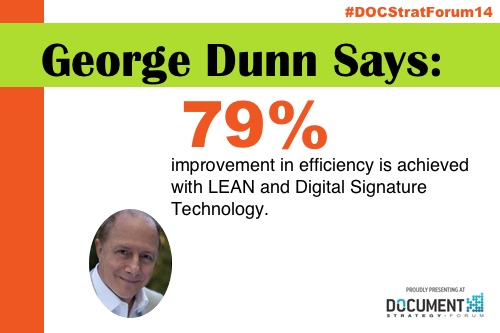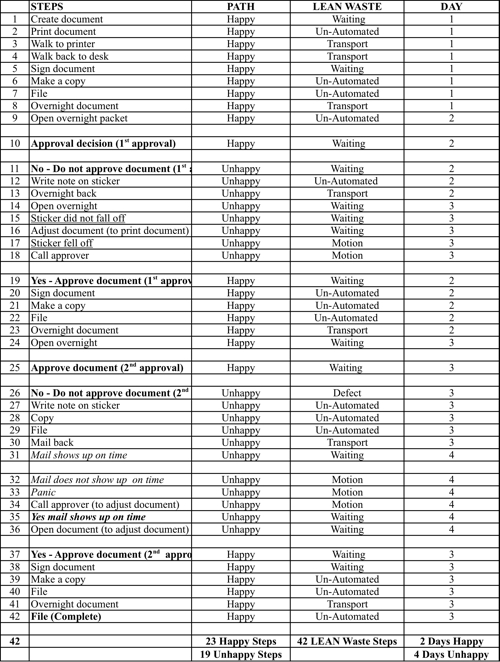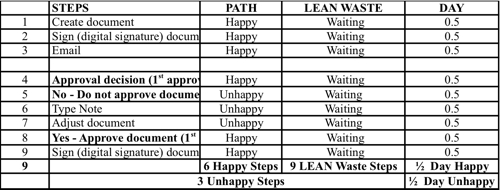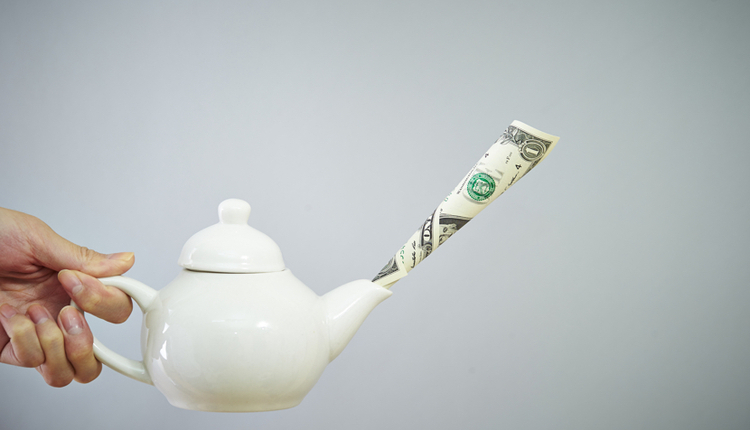
LEAN and digital signature technology results in 79% improvement in efficiency, 78% reduction in waste and customer service response time decreased from 2 or 4 days to ½ day.
What is LEAN?
LEAN, made popular by Toyota, focus primarily on reduction of waste to improve value to the customer. Muda (ç¡é§?) is a Japanese term that means effort that is unproductive. The seven wastes include:
1. Transportation: When a product is moved, it can be damaged, lost, delayed and additional cost can be incurred that does not result in value to the customer.
2. Inventory: Requires capital outlay by the customer or the manufacture.
3. Motion: Damage resulting from transportation through the manufacturing process or injury to workers.
4. Waiting: Time spent when a product is waiting for transportation or processing.
5. Over-processing: Additional work is done on a product than is desired by the customer.
6. Over-production: Product produced that is more than the customer requires.
7. Defect: Rework or rescheduling.
For purposes of this conversation, I will add an additional eighth waste: Un-automated: Manual tasks that can be replaced by technology. LEAN is founded on the belief that waste can be eliminated and asks the question: Does the process step provide value from the customer perspective?
What are digital signatures?
Digital Signatures are:
- An open, interoperable, US & international standard that confirms document integrity, signer identity and intent. Digital signatures complete the digital transformation.
- Online documents from start to finish: no more print, sign, scan of signed documents. The online document is the signed original document.
The manual signature baseline (below) shows 42 steps (23 happy path steps–doing it right the first time and 19 unhappy steps–rework). All 42 steps are some form of waste as defined by LEAN, including waiting time. The time to complete the happy path is two days, and the time to complete the unhappy path is four days.

Utilizing digital signatures and LEAN process improvement (technology to eliminate waste and elimination of second signature), the redesign shows nine steps (six happy path steps–doing it right the first time and three unhappy steps–rework). Nine of the steps are waste as defined by LEAN (all waiting time). The time to complete the happy path is half a day, and the time to complete the happy path is within the same half day.

Utilizing digital signature technology and process improvement (LEAN), process steps are reduced from 42 to nine (79%). LEAN waste steps are reduced from 42 to nine (78%). Transport time in best case (happy path) is reduced from two days to half a day and, for worse case (unhappy path), from 4 days to half a day.
Mr. Dunn will be presenting on Tuesday, May 13, 2014 at the DOCUMENT Strategy Forum. Don't miss his Power Session P204/P205 “Taking Automation a Step Further: Process Innovation & Advanced Paperless Technology.” For more information, visit www.DOCUMENTstrategyForum.com.
*As planning for process improvement and advanced paperless technology must to be tailored to the specific need of each organization, the information provided here should be treated as an introduction only, and, as such, without a direct consultation of requirements, CRE8 cannot assume responsibility for the use, implementation or results information provided. This article contains our understanding of LEAN. As there are many different definitions and books espousing LEAN methodology, the reader should conduct research to learn more about the specifics of this methodology.














